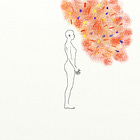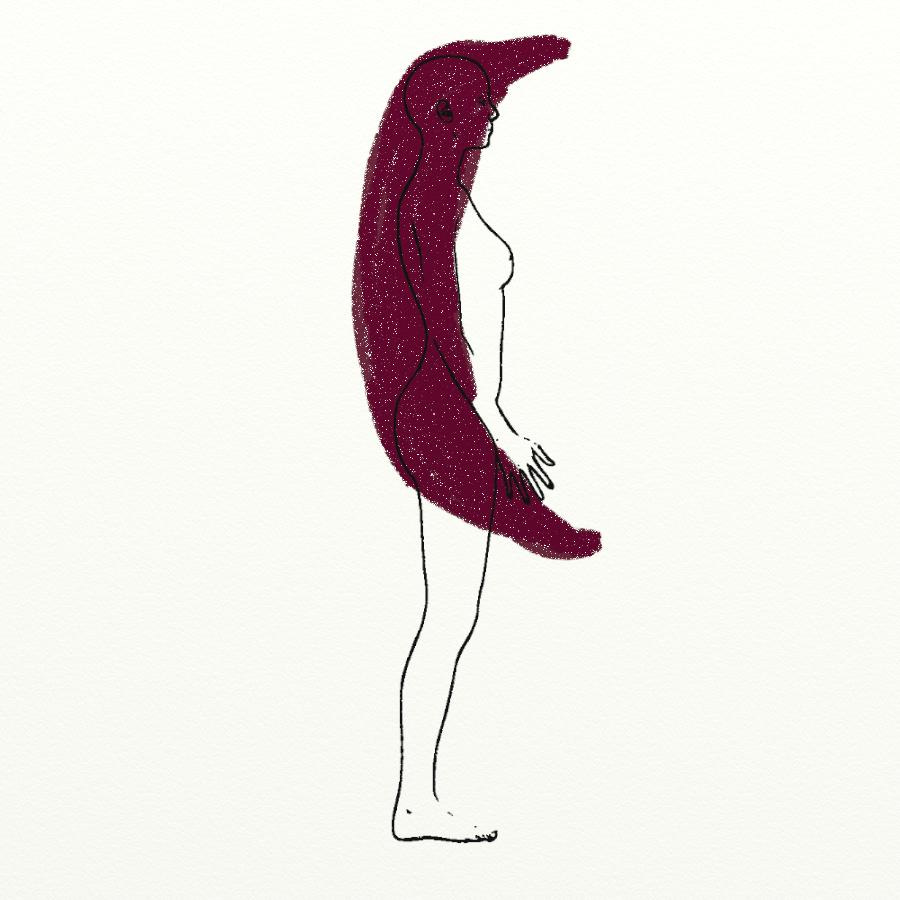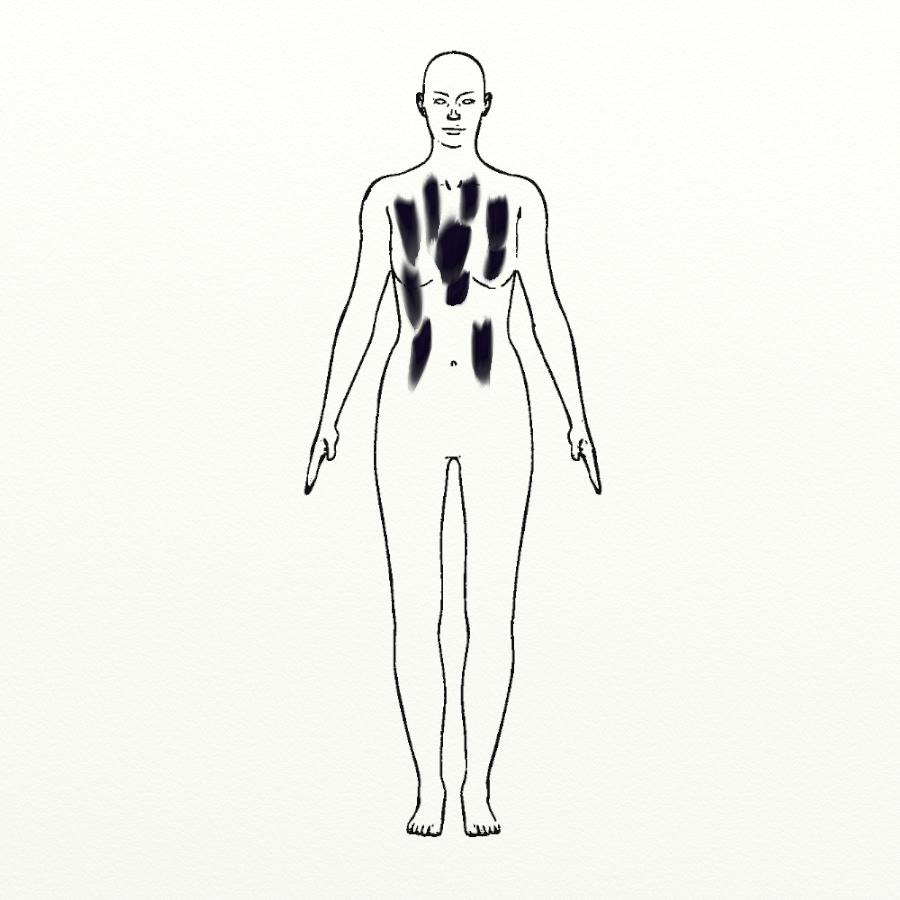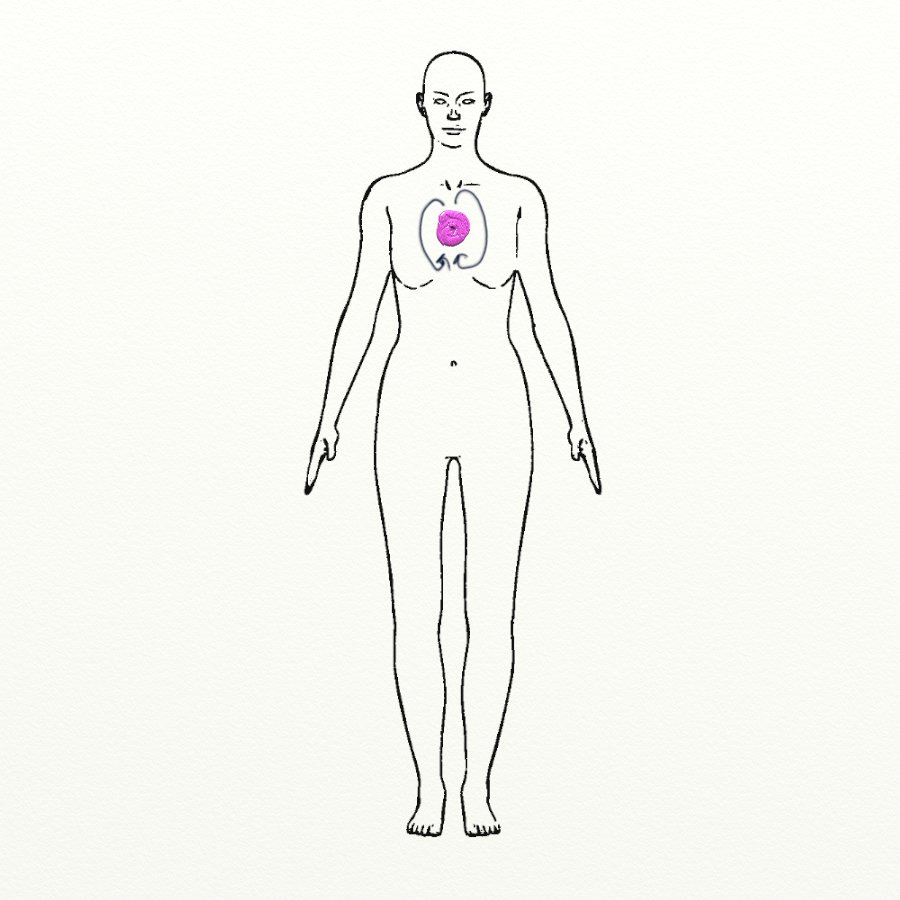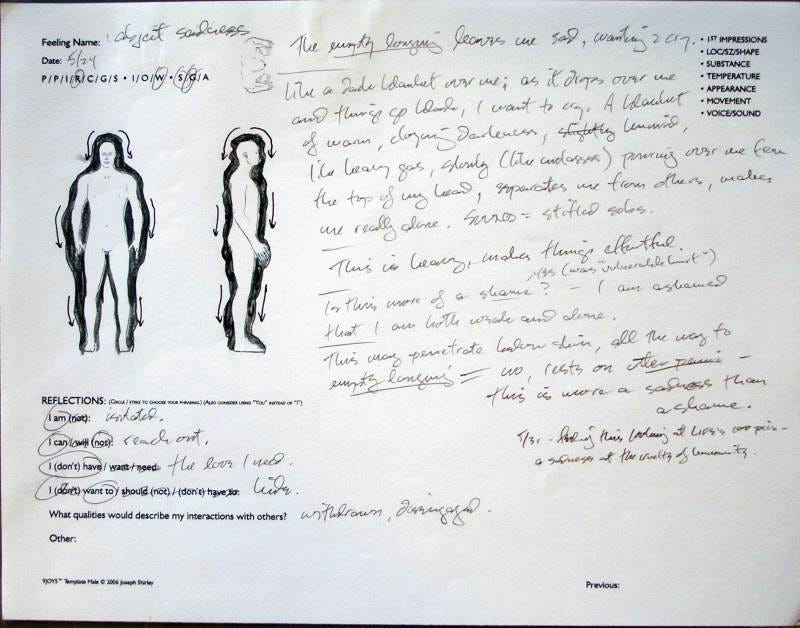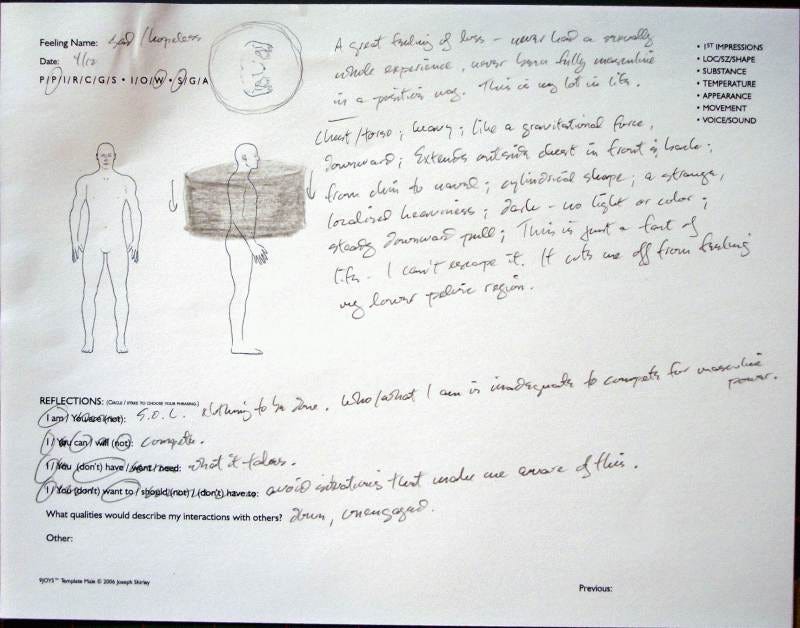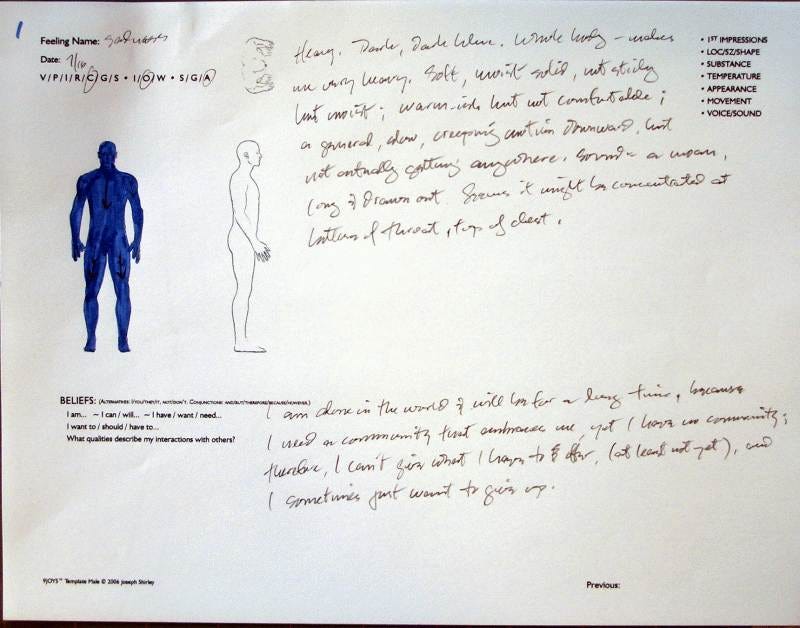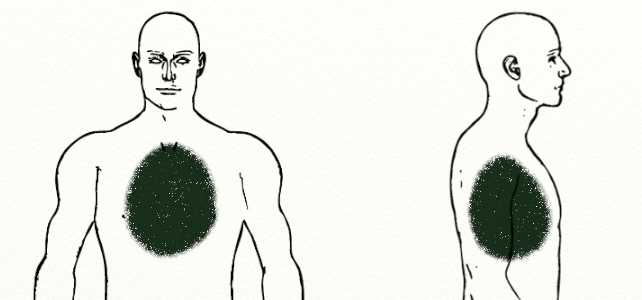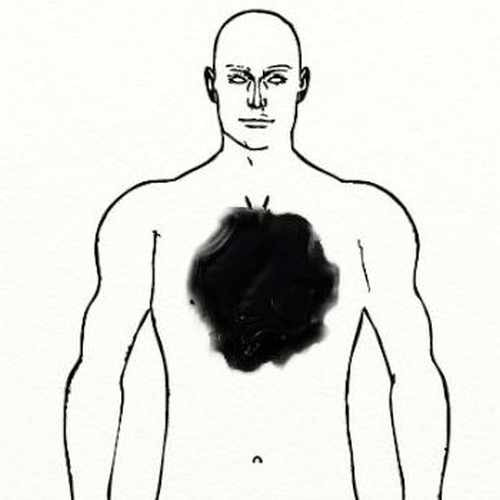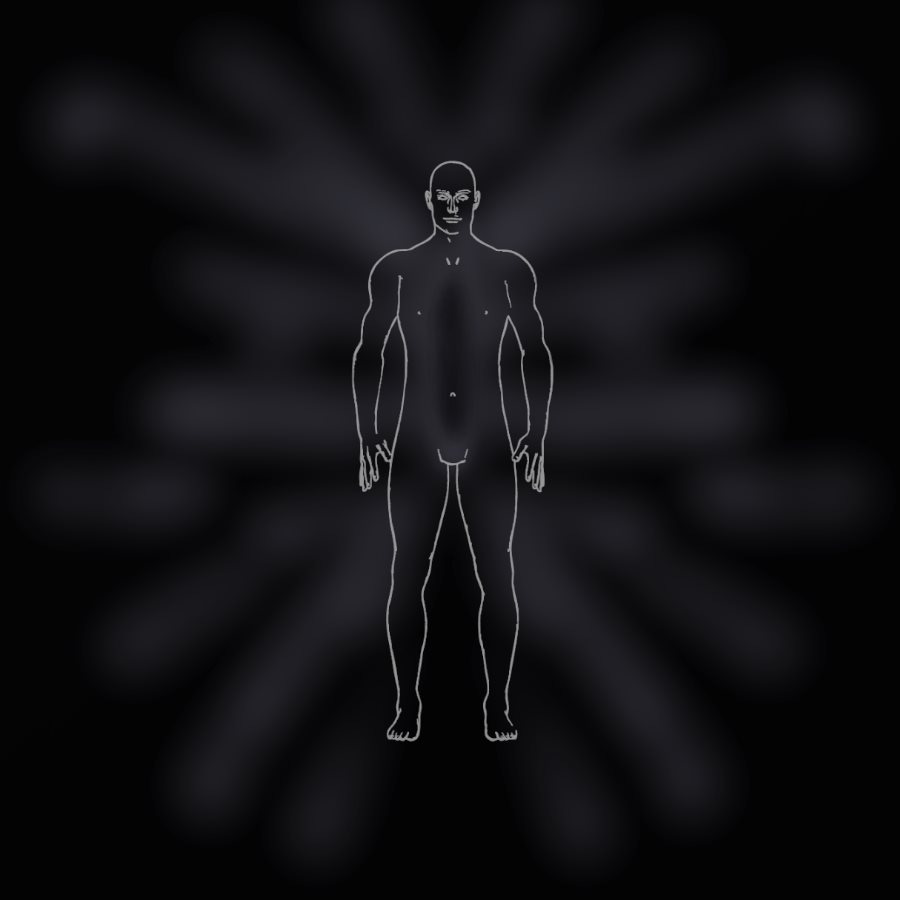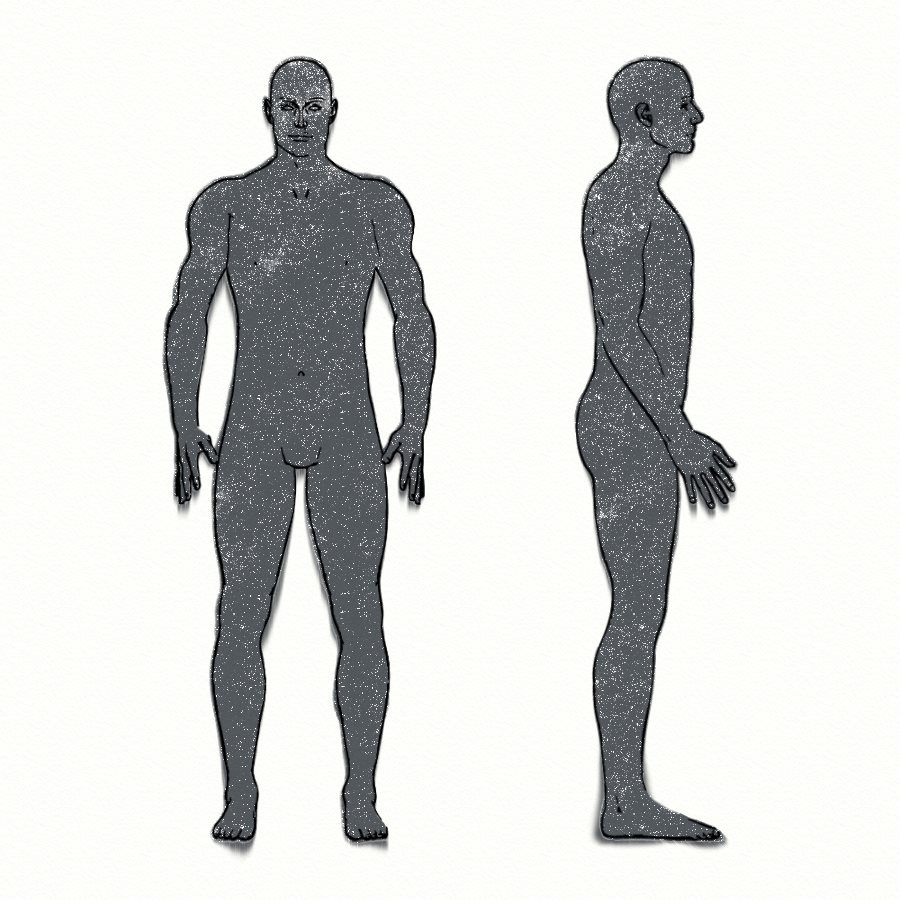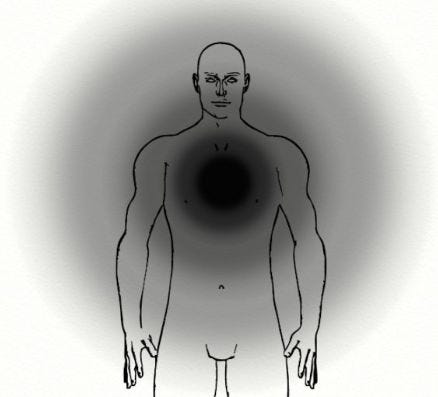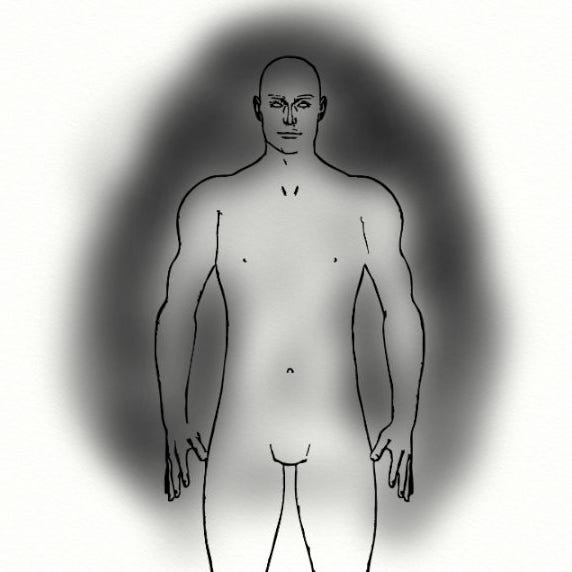A New Hypothesis: The Sadness Signature?
Investigating Consistency within the Same Person — Number 3 in the Observation Series
Previous post in this series:
Next post:
In the previous post in this series, Surprising Results as We Begin, we entered the initial observation phase of our science after hypothesizing that the experience of sadness might be universal in the way people experience its virtual material properties. Very quickly, within the first three states we mapped in three different people, we discovered a significant disparity in how the experience of what was named Sadness showed up for people. After nine more brief examples confirmed this diversity, our first hypothesis found itself hurled into the trash bin.
In order to proceed, we quickly devised a new hypothesis: that different people have different ways they experience the virtual material properties of such a universal emotion as sadness. In our new hypothesis, we proposed that each person carries a unique “sadness signature.”
We have already established that within short-enough time frames, when we are observing the virtual material properties connected to a specific, unique feeling state to which our observer has given the name Sadness (or something close to that), we find that, if we have done a good job of collecting our initial observation data, we will find the same configuration upon a second visit.
So, in essence, we are proposing that this configuration of virtual material properties for the feeling of Sadness for a specific person will remain consistent as that person revisits their experience of sadness over time. While their personal configuration of virtual material properties for this feeling may differ greatly from that of another person’s experience, within their own inner world, we hypothesize a consistency over time.
Well, how do we proceed? We can test our hypothesis by revisiting the experience of Sadness over longer periods time, using fieldwork to map the virtual material properties of sadness as it arises within different life issues or contexts for the same person, perhaps separated by time periods of months or even years.
Three Observations from Rebecca
Jumping into this question of whether people might carry a personal “sadness signature”, we will examine three observations of Sadness from a woman I’ll call Rebecca (not her real name) collected over a period of about six months.
Sad and Lonely, in the Context of “What’s Wrong with Me?”
Our first observation came in July, exploring overall issue she named, “What’s Wrong with Me?” The essence of this issue centered on the experience of not being liked, or at least a deep belief that she is not like. She said, “
Nobody likes me because of some essential flaw in my nature that I don't get social stuff.”
This issue was characterized by a number of different feeling states, including states she named Abandonment, Anxiety, Guilt and Hopeless. Among them was one she called Sad and Lonely.
Sad and Lonely
I'm always sad and lonely, even if I'm with somebody. I'm either trying to figure out how to be so they'll like me, or they really just don’t and there’s nothing I can do about it.
A curved shell around my back, a caving in; kind of like being inside an egg; tough solid, like leather kiwi skin (prickly) turned inside out, it has some give; outside of me, touching me, like I'm nested in it, fetal position; body temp; some sort of muted color tone; my front is still exposed, but I could choose to close it and peek out; no movement; things look different when I'm in this state, dangerous; a groany sigh, my voice.
I'm totally alone. Nobody could ever love me. People near me are potential sources of making it worse. Keep them away, stay away from people, because they'll just say or do something to further reveal the truth, which is that I'm unlovable or unworthy or that I don't matter. I don't belong. I am nobody. I am shit. This is very sad.
Deeply Sad, in the Context of “Voted Off the Family”
The next encounter with sadness came in December, about five months later. The context was an issue Rebecca referred to as “Voted Off the Family,” and it had to do with a relationship history of having been emotionally abandoned.
Rebecca experienced “Voted Off the Family” as carrying a number of feeling states including those she named Great Danger, Hurt, and Longing for Connection. Among them was one she called Deeply Sad.
Deeply Sad
In my chest/torso; black; these dark places, one big one on my heart, these distinct, stationary places, and from those places there is an oozing down; thick fluid, “blood tar," constant oozing, down about four inches from each place; comes in waves of intensity, heavier and more concentrated in the center of my chest; warm, like the temperature of freshly killed prey; sound of me bawling.
(Also, there are tears.)
It wants to be held. When I get there I just want to be held. I am very sad. Could be for any number of reasons. I just want to be comforted, specifically held or touched.
Deep Sadness, in the Context of Connection-Phobic
Finally, later in the same month, Rebecca was exploring another issue she called Connection-Phobic. In this pattern, she carried a hidden expectation of being deeply disappointed in her connections because of an underlying feeling that she was not worthy of caring and support. So she maintained a kind of irritable defensiveness with many people.
The states that Rebecca named as part of this pattern included Armored, Deeply Worthless, and Irritation. Among them was one she named Deep Sadness.
Deep Sadness
Heart; solid or vacuum; warm neutral; purple; turning inside out; hurts; sick heart.
I am damaged. I am sad and miss my soul of sweetness. It is not safe to be sweet, gentle and kind. I don't want to have to be this strong.
What to Make of This?
The bottom line here is that over the course of Rebecca doing inner work on a series of issues in the course of half a year, she mapped a strong feeling of sadness three distinct times. Each of these three observations yielded very different configurations of the feeling experience’s virtual material properties. Very different.
Once again, it seems we are forced to question our hypothesis. It doesn’t hold up so far with n=1. There seems to be no such thing as a “sadness signature,” at least not for Rebecca. And honestly, Rebecca is no outlier among humans. While she has her gifts and challenges, she seems to be fairly “normal” when it comes to experiencing feeling, mood and emotion. So if such a sadness signature does not show up in Rebecca, then it raises doubts about whether we can find that in anyone else.
But just to make sure, let’s take one more pass through another person’s experiences of multiple encounters with sadness. I’ll offer some examples from my own extensive mapping.
A Bunch of Samples of My Own
At different times over the years, as I’ve mapped many states, I have come across a state to which I have given a name close to or strongly related to “sadness.” These have been in different contexts, anchored in different earlier stages of my life, oriented toward different functions and portions of my inner life, and each has taken on a different configuration of virtual material properties.
Let’s take a tour.
Three Examples from 2007
The following examples are from a period in which I was still capturing my notes in handwritten form. I can’t say that much about the larger contexts for these.
Abject Sadness
Sad/Hopeless
Sadness
Grief/Sorrow, in the Context of Authority / Vicious Enforcer (2008)
I mapped this one in 2008 in the course of digging into the experience of an inner tyrant I discovered inside of me.
Grief/Sorrow
Very heavy in my chest, my heart, quite large, a good foot in diameter or so, hard solid, resilient like rubber; black/opaque/dull; warm; a very slight pulsing variation in the intensity of the weight of it, corresponding with an expansion and contraction in size, not so much a pushing out or pulling in as just the amount of stuff gets more or less, and more is heavier, a slow pulse, like over a minute or more with each beat. Sound is a long, protracted groan, never-ending.
I have lost so much joy and pleasure, especially in connecting with and loving others, as a result of the damage I sustained in our toxic culture and the supreme effort I had to make to overcome that damage, (and continue to have to make today, working to help others overcome similar damage). My life may be meaningful, but only in the context of a world of hurt. I would prefer to have been born into a world of goodness and celebrated life every day I was alive.
Sadness, in the Context of Shouldn’t Be Here (2009)
The next example I offer you comes from Sadness #2 in the previous post in this series, [[Science Observation 2-Difference|Conducting Our First Observations]]. I mapped this in 2009, in the context of a pervasive issue I called Shouldn’t Be Here. Again, here’s a brief summary of its properties:
Sadness
In my heart. Intense heaviness, crushing inward like a black hole. Like a ball of pie crust, a very dense clay, oily, like plasticine but pitch black. Intense cold. Intensely black as if you are peering into the maw of infinite sorrow. No sound. Steady gravity.
Thoughts/Beliefs: About all the pain — my parents' & others' as well as my own. There is too much pain, too much fear, too much grief, too much loss, too much devastation. Too much for any human to bear. I cannot bear it.
Great Sadness, in the Context of Unless (2018)
Let’s skip ahead nearly a decade to some work I was doing in the context of three interwoven patterns I called Unless, Don't Wanna Be Here, and Devastating Vulnerability.
Great Sadness
Sets the overall tone for Unless. Even if some consummation of “unless" emerges, the life I've had to live in order to get there has been filled with great and pointless suffering. Nothing can make that worthwhile. Nothing can turn the darkness of my suffering into light.
This is a great, stark, empty, silent blackness that crushes my heart with its emptiness, collapses with all the dark mass of empty space into my core. Neutral temp. Extends out as far as my awareness, centered on my vertical core. Echoing sound of sobbing. No movement, only force/pressure/weight/gravity.
Nothing makes this right. Nothing can ever make this right. There is only everlasting pain.
Demoralized Sadness, in the Context of Unless (2020)
This one was mapped in 2020 in the context of work under the title of Insatiable Need, specifically a pattern in which I had assessed that life was not worth it unless I was to succeed in my quest.
Demoralized Sadness
Starting above the back of my throat, stretching down through the neck into my upper chest. Bent with a forward-facing concavity, more-or-less cylindrical, somewhat flattened in the plane of the body. My head wants to hang forward in alignment with its bend. Nearly black; a very dark, neutral gray, opaque. A resilient solid, similar to tire rubber or a little softer. Heavy. Warm. A steady drone similar to the tone of voice of Tuvan throat singers, very deep, no fluctuation.
I give up. There's no point in trying. The job is too vast, the resistance too strong. Nothing will change in my lifetime, or in any time frame within which I could possibly have influence. It doesn't matter what I've done so far. It won't make a difference.
Pervasive Sadness, in the Context of Helpless Surrender (2020)
This one emerged in an exploration linked to the larger pattern that included the Demoralized Sadness above, a sense of Helpless Surrender in a larger context that I called Homeless in the Apocalypse.
Pervasive Sadness
A sense of grief at how long I've persisted with my work without any acknowledgement, and no sense that it would ever come to something.
Whole body, as if it is made of clay, dark gray-brown color. The gray is more cool, as if this clay has fine charcoal dust mixed through it. Not moist, but it behaves as though soft like moist clay, holding its shape fairly well but with a sagging. About the density and weight of clay. It's as if I can feel it in any part of my body from eyelids and fingers to torso, hips, and legs. It all feels heavy, not wanting to move, wanting to surrender into passivity and grief. Warm. (Oddly so; greater warmth brings more closeness to tears.) Sound of whimpering sighs, faint, not calling attention to themselves but released under the breath.
I grieve the losses in my life: the loss of joy, the loss of my own family, the loss of vibrant health, the loss of purpose and destiny, the loss of choice and expression. I grieve the loss of my life. It does not belong to me. It has never belonged to me.
Grief/Despair, in the Context of All Wrong (2023)
I mapped the following state in exploring a pattern I called All Wrong. Here’s how I described that: “I see everything about my father, and all of the behaviors of our western civilization from which he was formed, as perilously, egregiously, shamefully wrong. And I am committed to demonstrating that wrongness, and I want above all for there to somehow be consequences for it.”
Grief/Despair
A bone-crushing heaviness, a grief beyond words, an infinite well of sadness. A gravitational field influence that goes out several feet in all directions, and this energy kind of fills the entire space but is most highly concentrated in a ball of about three inches diameter in my chest. The ball is pure black, the field is transparent but visible, with a barely discernible translucence. Still, not moving. A prehensile silence that wraps itself around everything.
I don’t know what to do. I don’t know how to be. I don’t want to be here. This is all wrong and I don’t see any way out.
Despairing Grief, in the Context of Hero Dude (2023)
I mapped this in the context of a pattern I called Hero Dude (related to All Wrong and the Grief/Despair above), a kind of grandiose attachment to my work as a contribution to the liberation of society.
Despairing Grief
Hips and above, entire upper body, extending outward maybe a foot in all directions, a dark, miasmic cloud. Saturated, very damp, very warm, black. Mostly on the outside of me but seeking to enter from all directions, especially through my breath. My body is occupied at maybe 50% density compared to the outer portion. The sense is of gradually increasing density, and it is this vector of intensification that brings the strongest sense of grief. Things are getting worse. The meaninglessness of my life is increasing. Some aimless drifting movement. There is a strange sound, some kind of muffled friction, like of a body being dragged across a concrete floor in a sound studio with sound-dampening material on all surfaces.
Re-evaluating Our Hypothesis
Hm. So much for the idea of a “sadness signature.” We might think, well, maybe sadness is weird, and that we should try again with a different kind of feeling state like happiness. But in this last case, reviewing ten different observations of feeling states that carried the name or the common sense of “sadness” in the same person, and finding every single one of them dramatically different from the others, we’re left with an unavoidable conclusion. We need to ditch our hypothesis. We have encountered no evidence that it is viable and lots of evidence that disproves it resoundingly.
Oh, well.
Updating Our Working Map
But!! We must also recognize that we have learned something that may perhaps be very important. It seems that the context within which a person experiences a feeling state has a lot of power, directly impacting how a feeling state is manifested in its virtual material properties. Or something like that. At the very least, we need to introduce context as an important factor.
How about if we propose a third entity of our map, the life context? The life context for a feeling state involves a particular arrangement of activity, location, relationship and other factors of a person’s life within which this feeling experience is common, outside of which it may not be. That is to say, for any person, a specific feeling state is relevant to certain situations and conditions, and we want to hold that context as important in our exploration. We might capture it in formula-form like the following.
FeelingA ⟺ ContextA
In this case, the meaning of the directionally symmetrical symbol “⟺” is probably best summarized as “is mutually relevant to.” A specific feeling state A is mutually relevant to a specific life context A. Combining this with our initial map statement, that a unique feeling experience is essentially equivalent to a unique configuration of virtual material properties, we get something like this.
ContextA ⟺ (FeelingA ☰ VM-propertiesA)
Now, let me acknowledge that once again, n = 2 is a very small sample size. But let me reassure you that if we continue to work with other subjects to observe the feeling of sadness (or any other feeling state) in multiple contexts over time, we will find a similar diversity of form within each person.
Where Do We Go Next?
OK, let me ask you a leading question here. Have you noticed anything… well, shall we say “weird”… about the observations we’ve made so far? I mean, if you need to, just go scan this post and come back after you’ve reviewed all of the states.
What stands out to you? Specifically, don’t you think it’s rather unexpected that we find so many unusual virtual material properties? Let me just list a few of them for you:
dark, miasmic cloud
a gravitational field energy
similar to tire rubber
all the dark mass of empty space
intense cold
like a gravitational force
like heavy gas slowly pouring over me
oozing, thick “blood tar”
solid or vacuum (?)
like leather kiwi skin (prickly) turned inside out
And even more strange, how is it that so many of these occupy space that extends outside the body?! Just scan over the drawings, and you see almost half of them document the virtual material properties existing beyond the surface of the body.
Take a step back and hold this up to our long-standing assumptions about the fundamentally somatic basis for what feeling is and how it works.
This is not a trivial incongruence. And it warrants collecting many more observations. In the next post, I will share a few further examples to illustrate just how diverse and sprawling things can get, and we will try to reckon with that.
Reflections
Please let me know how this all lands for you in the comments, or feel free to reach out directly through DM or email (reply if you’re receiving this by email, or use the Frontiers of Psychotopology URL with an @ sign between “frontiers” and “psychotopology” to email me directly). I’m curious to hear from you. And if you’re not yet subscribed, please consider doing so!



